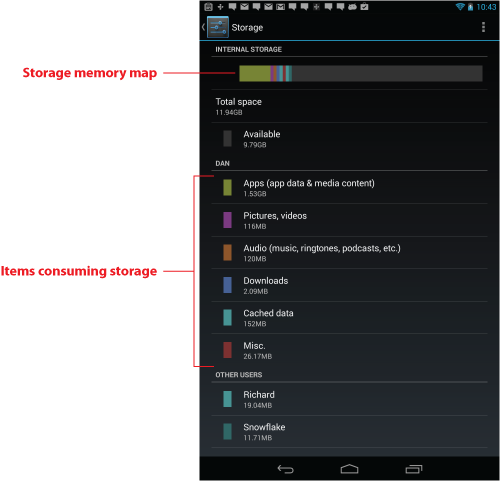I’ve not seen it on any of my Android devices, but apparently there’s an error message. It reads, “Insufficient storage available.” That reminds me of the old MEM error message that appeared in Lotus 1-2-3.
Memory errors were common in the PC’s early days. Of course, back then desktop computers had only 640K of RAM. Today’s cell phones and tablets usually have about 16GB — over 16 million times more storage. Yet even that much storage can be consumed quickly.
To discover what culprit is gobbling up storage on your phone or tablet, check out the Storage item in the Settings app:
- Open the Settings app.
- Choose the Storage category.
- Observe the memory map at the top of the screen.
Used and unused storage on your device appears on a memory map, similar to what’s shown in Figure 1. In that Figure, the storage is still pretty much unused, but for a device low on storage you would see vast expanses of color on the bar chart.

Figure 1. The Data Storage screen describes how internal storage is allocated.
Storage categories are color-coded, as shown in Figure 1. That way you can narrow down where the hog dwells: Pictures, videos, music, downloads, and so on.
Match the largest chunk of the bar chart with the categories at the bottom of the screen. Touch a category to view the details.
For example, choose the Pictures, Videos category (shown in purple in Figure 1) to see a list of the pictures and videos stored on the device. You may be prompted to start a specific app; do so. Then browse through the items to see which one is consuming great quantities of storage, or just which of them you’d be okay deleting.
Sometimes choosing a category opens an app, sometimes the category displays a list of items you can browse. For example, the Downloads category displays a list of downloaded items. You can select one or more and then delete the hefty ones to free up some storage space.
Before you opt to remove items from your phone or tablet, I recommend connecting the device to a computer. That way you can copy the piggy files to the computer for long-term storage as opposed to merely obliterating them. The PC is better able to handle large-capacity files than a mobile device.
As an example, you could copy a 2.4GB video to your PC and then remove it from the tablet. That way you can keep the video file, archive it to a DVD, or upload it to YouTube. Then you can remove the duplicate copy on the tablet to free up some storage.
After exorcising the offending files, check the data storage on your phone or tablet again. You should find plenty of room that you can once again eagerly fill up with various goodies.


>>”Of course, back then desktop computers had only 640K of RAM. Today’s cell phones and tablets usually have about 16GB”<<
lets first clarify that most Android smartphones have between 512mb and 2gig of RAM
So as far as actual internal storage, my smartphone (Avail 2) only has 2 gigs of internal storage, but Ive added a 64 gig microSD card so now I can take a couple of hours of video if I want.
Comment by BradC — October 31, 2013 @ 1:13 pm
Thank you, BradC for the clarification!
Even a paltry 512mb is far, far more memory than the PC’s original max of 640K.
Annoying history: Actually, it originally was 512K. The address space for the 8086 was 1MB, so they split it in two: 512KB for RAM and programs and 512KB for ROM and firmware. The needed only a sliver of that however, and fortunately they placed the video buffer at the 640K mark, so they could expand RAM to 640K.
Okay, enough annoying history.
Comment by admin — October 31, 2013 @ 2:41 pm